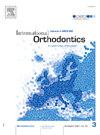一项随机对照试验:基于cbct的评估年轻人使用唇与舌固定矫治器正畸治疗I类中度拥挤后的根根吸收和牙槽骨高度
IF 1.9
Q2 DENTISTRY, ORAL SURGERY & MEDICINE
引用次数: 0
摘要
目的:根尖吸收和牙槽骨丢失是正畸治疗的潜在并发症。本研究旨在利用CBCT成像评估使用唇形和舌形固定矫治器矫治中度拥挤患者后的根尖吸收和牙槽骨高度。研究对象和方法:所有符合资格标准的患者于2022年3月至2022年6月在大马士革大学牙科学院正畸科就诊。该研究涉及被诊断为I类错颌和双牙弓中度拥挤的患者,可以在非拔牙的基础上进行治疗。参与者被随机分为两组。一组使用舌器(DTC®IN-Tendo JK-SL, DTC医疗器械有限公司,杭州,中国)0.018英寸槽。使用的弧线顺序为0.012″、0.014 0.016″镍钛、0.016″×0.022″TMA、0.016″×0.022″不锈钢、0.017″×0.025″不锈钢。另一组接受唇部直丝矫治器(AO Mini Master®- MBT系统,金属托架,Sheboygan, WI, USA)治疗,也具有0.018英寸槽。采用的弧线顺序为0.012″、0.014″、0.016″镍钛、0.016″×0.022″镍钛、0.016、0.017″×0.025″不锈钢。CBCT图像分别于治疗开始前(T0)和治疗结束后1天(T1)拍摄。在这些评估时间内评估上、下牙的根尖吸收和牙槽骨高度。组间差异采用配对样本t检验,组内变化采用双样本t检验。结果:40例患者中,每组19例患者纳入统计分析(男性16例,女性24例;平均年龄21.3岁)。在两组中,T1时所有被研究的牙齿长度都显著减少(p结论:在治疗中度挤牙时,使用DTC®舌牙或AO Mini Master®带弓丝序列的唇托槽与临床可接受的轻度至中度牙根吸收和临床不显著的牙槽骨丢失相关。两种病例的记录吸收率均小于1.34mm。舌形矫治器比唇形矫治器对下门牙的吸收更大。下颌中切牙使用舌形矫治器时舌骨流失更大,而下颌后切牙使用唇形矫治器时前庭骨流失更大。本文章由计算机程序翻译,如有差异,请以英文原文为准。
CBCT-based assessment of apical root resorption and alveolar bone height following orthodontic treatment of Class I moderate crowding with labial vs. lingual fixed appliances in young adults: A randomized controlled trial
Objectives
Apical root resorption and alveolar bone loss are potential complications associated with orthodontic treatment. This study aimed to assess apical root resorption and alveolar bone height following orthodontic treatment of moderate crowding with labial vs. lingual fixed appliances using CBCT imaging.
Subjects and methods
All patients meeting the eligibility criteria were included from March 2022 to June 2022 at the University of Damascus Faculty of Dentistry, Department of Orthodontics. The study involved patients diagnosed with Class I malocclusion and moderate crowding in both arches that could be treated on a non-extraction basis. Participants were randomly divided into two groups. One group was treated using lingual appliances (DTC® IN-Tendo JK-SL, DTC Medical Apparatus Co., Hangzhou, China) with a 0.018-inch slot. The sequence of archwires used included 0.012″, 0.014 0.016″ nickel-titanium, 0.016″ × 0.022″ TMA, 0.016″ × 0.022″ stainless steel, and 0.017″ × 0.025″ stainless steel. The other group received treatment with labial straight-wire appliances (AO Mini Master® – MBT System, metal brackets, Sheboygan, WI, USA) also featuring a 0.018-inch slot. The sequence of archwires used was 0.012″, 0.014″, 0.016″ nickel-titanium, 0.016″ × 0.022″ nickel-titanium, 0.016 and 0.017″ × 0.025″ stainless steel. The CBCT images were taken before the commencement of treatment (T0) and one day following the end of treatment (T1). The apical root resorption and alveolar bone height of the upper and lower teeth were assessed at these assessment times. Paired-sample t-test used to analyse the intergroup differences, while a two-sample t-test was employed to assess intragroup changes. The significance level was set at P < 0.004 after adjustment using Bonferroni's correction.
Results
Out of forty patients, nineteen patients in each group were included in the statistical analysis (16 men and 24 women; mean age: 21.3 years). In both groups, there was a significant decrease in the lengths of all studied teeth at T1 (P < 0.004). The apical resorption was significantly greater in the lingual appliance group for lower central and lateral incisors compared to the labial appliance group (0.64 mm, 0.7, respectively). The mean lingual bone loss in the lingual appliances was statistically greater than that in the labial appliances for lower central incisors (0.53 mm), while the mean buccal bone loss in the labial appliance group was statistically greater than that in the lingual appliance group for the lower lateral incisors (0.52 mm).
Conclusions
The use of DTC® lingual or AO Mini Master® labial brackets with archwire sequences is associated with clinically acceptable mild to moderate root resorption and clinically insignificant alveolar bone loss when treating moderate crowding. The record resorption in both cases is less than 1.34 mm. The lingual appliances cause greater resorption of lower incisors than labial appliances. Lingual bone loss is greater with lingual orthodontic appliances for lower central incisors, while vestibular bone loss is greater with labial orthodontic appliances for the lower later al incisors.
求助全文
通过发布文献求助,成功后即可免费获取论文全文。
去求助
来源期刊

International Orthodontics
DENTISTRY, ORAL SURGERY & MEDICINE-
CiteScore
2.50
自引率
13.30%
发文量
71
审稿时长
26 days
期刊介绍:
Une revue de référence dans le domaine de orthodontie et des disciplines frontières Your reference in dentofacial orthopedics International Orthodontics adresse aux orthodontistes, aux dentistes, aux stomatologistes, aux chirurgiens maxillo-faciaux et aux plasticiens de la face, ainsi quà leurs assistant(e)s. International Orthodontics is addressed to orthodontists, dentists, stomatologists, maxillofacial surgeons and facial plastic surgeons, as well as their assistants.
 求助内容:
求助内容: 应助结果提醒方式:
应助结果提醒方式:


